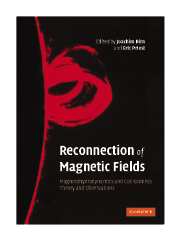5 - Reconnection in the Sun's atmosphere
Published online by Cambridge University Press: 17 August 2009
Summary
Coronal heating
E. R. Priest
Understanding how the Sun's outer atmosphere, or corona, is heated to a few million degrees by comparison with the temperature of its surface (or photosphere), namely only 6000 K, is one of the major challenges in astronomy or plasma physics. Until thirty years ago the main way of glimpsing the corona was during a solar eclipse (Fig. 1.1a), when the Moon cuts out the glare of the photosphere in white light and the much fainter corona comes into view with beautiful structures that are dominated for the most part by the magnetic field.
The corona has a threefold structure of coronal holes, coronal loops, and X-ray bright points, which was revealed by soft X-ray images from early rockets and Skylab. The Yohkoh satellite, in particular, has shown the corona to be an MHD world (Fig. 1.1b), with myriads of coronal loops continually interacting with one another. In the magnetically open regions (coronal holes) the plasma is streaming rapidly outwards as the fast solar wind, but in magnetically closed regions the magnetic field is able to contain the plasma at a higher density. Active regions lying above sunspot groups show up as a collection of loops in soft X-rays or EUV: images from the TRACE instrument reveal the highly complex nature of these loop systems (Fig. 5.1).
The energy required to heat the corona is typically 300 Wm–2 (3 × 105 erg cm s–1) in a quiet region or coronal hole and 5000 Wm–2 in an active region.
- Type
- Chapter
- Information
- Reconnection of Magnetic FieldsMagnetohydrodynamics and Collisionless Theory and Observations, pp. 229 - 301Publisher: Cambridge University PressPrint publication year: 2007
- 1
- Cited by



